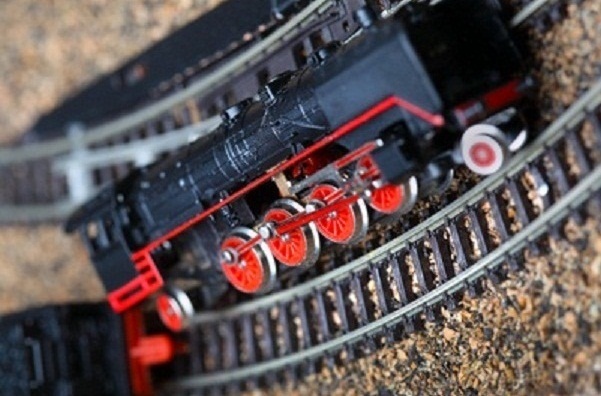Everything on model trains, model railroads, model railways, locomotives, model train layouts, scenery, wiring, DCC and more. Enjoy the world's best hobby... model railroading!
Tips to Avoid Model Train Derailments
Derailments are frequent and very annoying when you are trying to build a perfect railroad track. Here are a few tips to avoid them.
–> The joints must be well aligned and the gap between them must be kept to a minimum. The track should be smooth when you rub a finger over it.
–> Solder your sectional pieces in the end so that they remain fixed at one position.
–> The track gauge should neither be tight nor wide. If the track gauge is too tight the wheels could ride up and cause a derailment. If it is too wide the wheel flanges won’t span the track correctly, potentially causing a derailment. Heating the rail with a soldering iron can allow for the rail to be adjusted into position.
–> Make sure the switch points don’t grab the wheels. This sometimes happens with new switch points. A file can be used to carefully smooth the points (moveable parts) to achieve a smooth transition. Inspect the rail gauge when in each position.
–> The wheels must move freely and contact the rails evenly.
–> Ensure couplers don’t snag and are properly centered.
–> Check the length of your longest car if you are making an S-shaped track. It needs to be able to enter and exit the S curve without derailing.
–> Add additional weight to cars if they are too light. Aim for a low center of gravity with the weight in the towards the centre of the cars.
–> Lubricate frequently. If wheel sets are incorrectly aligned, out of gauge, or not rotating freely, they could cause a derailment. However, use oil sparingly as it does attract dust.
Add your suggestions and comments.
















In regards to lubricating wheels, bearings, etc., I have a suggestion. In the past I worked in the high tech lubricants industry. While many use light duty or sewing machine type oil for hobby applications, these lubes tend to attract dust and dirt as they dry. WD40 is also very bad for this issue. However, there are 2 options that work extremely well. MPC LUBRICANTS, make specialty lubricants for the US military, heavy industry and auto racing and will outperform EVERYTHING else on the market. BTW, I don’t work for them and I’m not self promoting.
FP-10 firearms lube doesn’t dry out, removes dirt from mechanisms while in use and is virtually frictionless which makes everything go faster, last longer and is also pretty cheap. For similar use, and an even lighter formulation, which also has the above capabilities and includes a moisture remover function is MO-10, MOIST OUT demoisturant lube. Either of these will make a noticeable improvement in speed and reliability and since they are heat activated, the hotter things get, the better they work. Standard lubes run away from heat and MPC lubes are attracted to heat and attack hot spots and cool things down. Also work amazing in RC drift/racing cars, my other hobby. Hope this is helpful.
the first comment is good. follow that. Also, look at the flange height for each wheel. if the flange is too deep the flange will ride up on the spike or plastic that holds the rail and cause derailment. I have an Atlas Kato N scale SD 9 that as I ran it slow it derailed at the same place at the start of a curve. If I ran it fast it would make it through OK. All my other loco had no problem. I sanded the flange down on the center wheel and that fixed the problem.
Good luck,
Mike Lee
This is so helpful, Thanks loads! My locomotives do this quite often and these tips are so useful!!!!
Thanks
Worth mentioning: make sure ballast is not fouling the inside surface of the rails or getting between switch point rails.